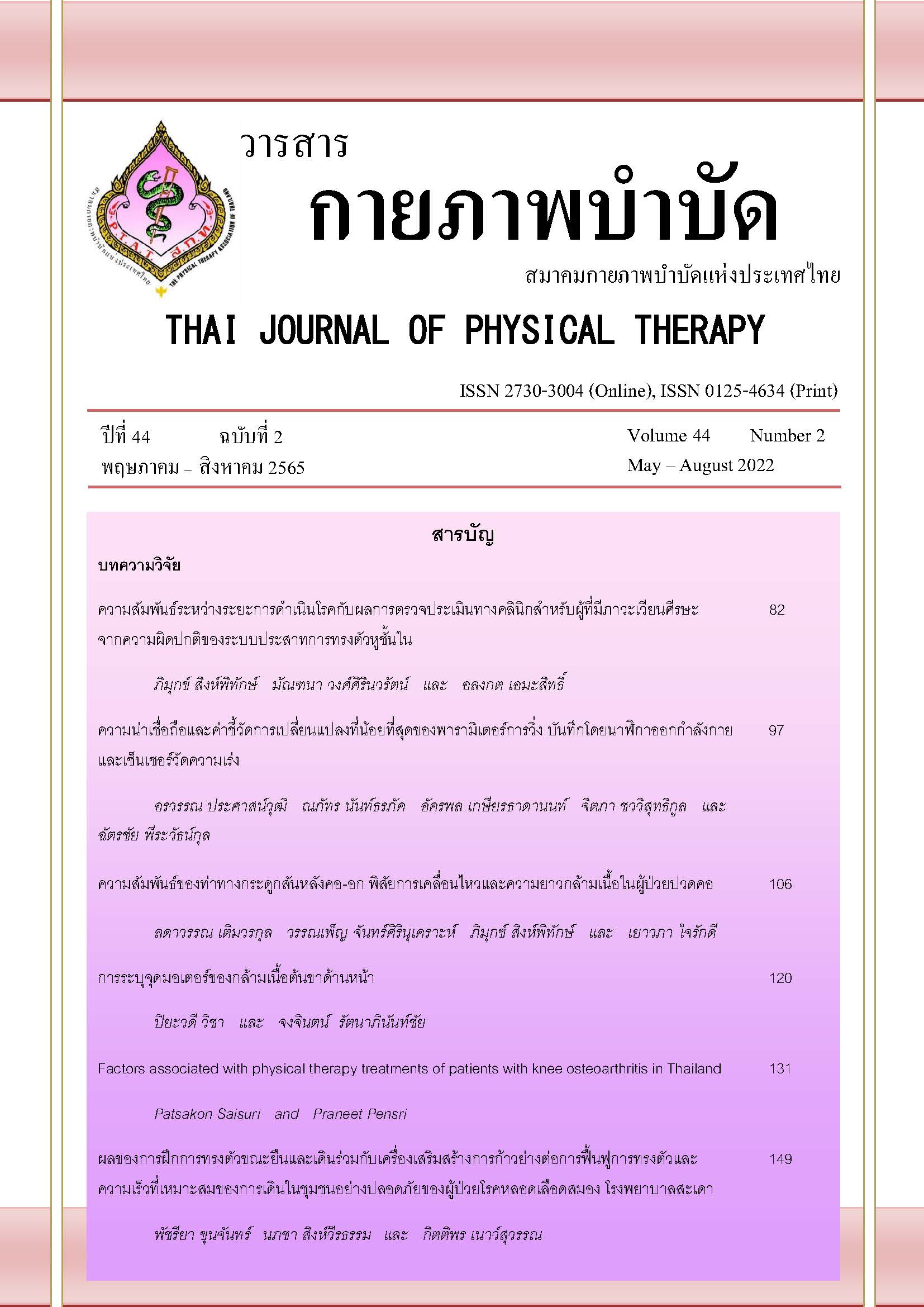ความน่าเชื่อถือและค่าชี้วัดการเปลี่ยนแปลงที่น้อยที่สุดของพารามิเตอร์การวิ่ง บันทึกโดย นาฬิกาออกกำลังกายและเซ็นเซอร์วัดความเร่ง
Main Article Content
บทคัดย่อ
ที่มาและความสำคัญ: นาฬิกาออกกำลังกายและเซ็นเซอร์วัดความเร่งบันทึกค่าพารามิเตอร์ของการวิ่งได้ อย่างไรก็ตาม ยังไม่เป็นที่แน่ชัดว่าค่าพารามิเตอร์นั้น มีความน่าเชื่อถืออยู่ในระดับใด
วัตถุประสงค์: เพื่อทดสอบความน่าเชื่อถือแบบวัดซ้ำ และค่าชี้วัดการเปลี่ยนแปลงที่น้อยที่สุดของพารามิเตอร์ของการวิ่ง
วิธีการวิจัย: อาสาสมัครสุขภาพดี จำนวน 20 คน สวมนาฬิกาออกกำลังกายและติดเซ็นเซอร์วัดความเร่งและวิ่งบนลู่วิ่งต่อเนื่องเป็นเวลา 5 นาที ด้วยความเร็วที่วิ่งได้แบบสบาย และทำการทดสอบซ้ำในวันถัดไปอีก 2 วัน (รวม 3 วัน) ด้วยความเร็วเดิม
ผลการวิจัย: ค่าความน่าเชื่อถือของการวัดซ้ำ (ICC 3,k) ของรอบขา ระยะเวลาที่เท้าเหยียบพื้น การโยกตัวขึ้นลงในแนวดิ่ง และความยาวก้าว มีค่า 0.98, 0.97, 0.95 และ 0.94 ตามลำดับ ซึ่งมีความน่าเชื่อถืออยู่ในระดับที่สูงมาก ค่าความคลาดเคลื่อนมาตรฐานในการวัด (SEM) มีค่าต่ำกว่าค่าดัชนีการเปลี่ยนแปลงที่น้อยที่สุด (MDC) ที่ระดับความเชื่อมั่น 95%
สรุปผล: รอบขา ระยะเวลาที่เท้าเหยียบพื้น การโยกตัวขึ้นลงในแนวดิ่ง ความยาวก้าว ที่บันทึกจากนาฬิกาออกกำลังกายร่วมกับเซ็นเซอร์วัดความเร่งมีความน่าเชื่อถือในระดับสูงมาก
Article Details

อนุญาตภายใต้เงื่อนไข Creative Commons Attribution-NonCommercial-NoDerivatives 4.0 International License.
เอกสารอ้างอิง
Nielsen RO, Buist I, Sorensen H, Lind M, Rasmussen S. Training errors and running related injuries: a systematic review. Int J Sports Phys Ther. 2012;7(1):58-75.
Yamato TP, Saragiotto BT, Hespanhol LC, Yeung SS, Lopes AD. Descriptors used to define running-related musculoskeletal injury: A systematic review. J Orthop Sport Phys Ther. 2015;45(5):366-74.
Saragiotto BT, Yamato TP, Hespanhol LC, Rainbow MJ, Davis IS, Lopes AD. What are the main risk factors for running-related injuries? Sports Med. 2014;44(8):1153-63.
Saragiotto BT, Di Pierro C, Lopes AD. Risk factors and injury prevention in elite athletes: a descriptive study of the opinions of physical therapists, doctors and trainers. Braz J Phys Ther. 2014;18(2):137-43.
Willy RW, Wilson JD, Clowers K, Baggaley M, Murray N. The effects of body-borne loads and cadence manipulation on patellofemoral and tibiofemoral joint kinetics during running. J Biomech. 2016;49(16):4028-33.
Wille CM, Lenhart RL, Wang SJ, Thelen DG, Heiderscheit BC. Ability of sagittal kinematic variables to estimate ground reaction forces and joint kinetics in running. J Orthop Sport Phys Ther. 2014;44(10):825-30.
Folland JP, Allen SJ, Black MI, Handsaker JC, Forrester SE. Running technique is an important component of running economy and performance.Med Sci Sport Exer. 2017;49(7): 1412-23.
Adams D, Pozzi F, Carroll A, Rombach A, Zeni J. Validity and reliability of a commercial fitness watch for measuring running dynamics. J Orthop Sport Phys Ther. 2016;46(6):471-6.
Milner CE, Ferber R, Pollard CD, Hamill J, Davis IS. Biomechanical factors associated with tibial stress fracture in female runners. Med Sci Sport Exer. 2006;38(2):323-8.
Clermont CA, Osis ST, Phinyomark A, Ferber R. Kinematic gait patterns in competitive and recreational runners.J Appl Biomech. 2017; 33(4):268-76.
Schmitz A, Russo K, Edwards L, Noehren B. Do novice runners have weak hips and bad running form? Gait Posture. 2014;40(1):82-6.
Douglas R, Federico P, Richard WW, Anthony C, Joseph Z. Altering cadence or vertical oscillation during running: effect on running related injury factors . Int J Sports Phys Ther. 2018;13(4):9.
Tartaruga MP, Brisswalter J, Peyre-Tartaruga LA, Avila AOV, Alberton CL, Coertjens M, et al. The relationship between running economy and biomechanical variables in distance runners. Res Q Exercise Sport. 2012;83(3): 367-75.
Gullstrand L, Halvorsen K, Tinmark F, Eriksson M, Nilsson J. Measurements of vertical displacement in running, a methodological comparison. Gait Posture. 2009;30(1):71-5.
Hunter JP, Marshall RN, McNair P. Reliability of biomechanical variables of sprint running. Med Sci Sport Exer. 2004;36(5):850-61.
Souza RB. An evidence-based videotaped running biomechanics analysis. Phys Med Rehabil Clin N Am. 2016;27(1):217-36.
Koo TK, Li MY. A Guideline of Selecting and Reporting Intraclass Correlation Coefficients for Reliability Research. J Chiropr Med. 2016; 15(2): 155–63.
Lee P, Liu CH, Fan CW, Lu CP, Lu WS, Hsieh CL. The test-retest reliability and the minimal detectable change of the Purdue pegboard test in schizophrenia. J Formos Med Assoc. 2013;112(6):332-7.
Andersen CF, Nielsen MS. Reliability and validity of garmin forerunner 735XT for measuring running dynamics In- field. 4Th Semester Thesis -sport science technology, Aalborg university. 2017:1-10.
Ahamed NU, Kobsar D, Benson L, Clermont C, Kohrs R, Osis ST, et al. Using wearable sensors to classify subject-specific running biomechanical gait patterns based on changes in environmental weather conditions. Plos One. 2018;13(9):e0203839.
Ahamed NU, Kobsar D, Benson LC, Clermont CA, Osis ST, Ferber R. Subject-specific and group-based running pattern classification using art single wearable sensor. J Biomech. 2019;84:227-33.


